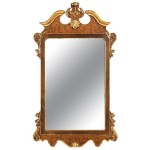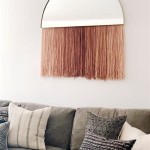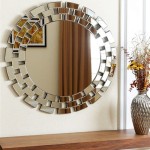What Can I Use to Put My Mirror On the Wall?
Securing a mirror to a wall requires careful consideration of the mirror's size and weight, the wall's material, and the desired permanence of the installation. Numerous options exist, each with its own set of advantages and drawbacks. Choosing the appropriate method is crucial for ensuring the mirror remains safely and securely in place, preventing damage to both the mirror and the wall, and achieving the desired aesthetic.
The selection process should begin with a thorough assessment of these factors. A small, lightweight mirror can often be mounted with relatively simple adhesive solutions. However, larger, heavier mirrors necessitate more robust hardware and installation techniques. Likewise, the type of wall (e.g., drywall, plaster, concrete, brick) will significantly influence the choice of mounting method. Each material possesses unique structural properties and requires specific types of fasteners for optimal grip and support.
Furthermore, the desired level of permanence is a key consideration. Some methods, such as heavy-duty adhesive tapes or mirror mastic, offer a relatively permanent bond, which may be suitable for mirrors intended to remain in place indefinitely. Other methods, such as using hanging kits with D-rings and wire, or employing z-clips, allow for easier removal and repositioning, which can be advantageous for renters or those who anticipate relocating the mirror in the future. Before any installation, thoroughly research the specific product and its instructions, and always prioritize safety and the prevention of damage.
Adhesive Solutions: Tapes and Mastics
Adhesive solutions offer a convenient and often less invasive method for mounting mirrors, particularly for smaller and lighter pieces. These solutions are generally easy to apply and eliminate the need for drilling holes in the wall, which can be beneficial for aesthetic reasons and for avoiding potential damage to underlying pipes or wiring. However, it is essential to select the correct type of adhesive and to prepare the surfaces properly to ensure a secure and long-lasting bond.
Double-sided adhesive tapes specifically designed for mirror mounting are readily available. These tapes typically consist of a strong adhesive layer on both sides of a foam or acrylic core, which provides cushioning and helps to distribute the weight of the mirror evenly. When selecting a mirror mounting tape, it is crucial to check the manufacturer's specifications for weight capacity to ensure it can adequately support the mirror's size and weight. The tape should also be compatible with both the mirror's backing and the wall surface. Prior to application, thoroughly clean both surfaces with a suitable cleaner to remove any grease, dust, or debris that could compromise the adhesive bond. Follow the manufacturer's instructions carefully for proper placement and application pressure.
Mirror mastic is a more permanent adhesive solution that provides a stronger bond than adhesive tapes. This type of adhesive is typically a thick, paste-like substance that is applied directly to the back of the mirror before it is pressed against the wall. Mirror mastic is formulated to be compatible with the reflective backing of mirrors and to prevent damage to the silvering. It is essential to use a mastic specifically designed for mirrors, as other types of adhesives may contain chemicals that can corrode or damage the reflective surface. As with adhesive tapes, proper surface preparation is crucial for a successful installation. The wall surface should be clean, dry, and free of any loose paint or wallpaper. Apply the mastic in vertical beads across the back of the mirror, leaving some space for air circulation. Press the mirror firmly against the wall and support it with tape or shims until the mastic has fully cured, as specified by the manufacturer.
When using adhesive solutions, it is imperative to understand their limitations. They are generally best suited for smooth, non-porous surfaces such as painted drywall or tile. They may not adhere well to textured walls, wallpaper, or surfaces with loose paint. Furthermore, removing a mirror that has been mounted with a strong adhesive can be challenging and may result in damage to the wall. Consider the long-term implications before opting for an adhesive solution.
Hanging Kits with D-Rings and Wire
Hanging kits offering a degree of flexibility are suitable for mirrors that may need to be moved or repositioned periodically. These kits typically consist of D-rings, wire, and associated hardware for attaching the wire to the back of the mirror. They allow the mirror to be suspended from a hook or nail in the wall, providing a more adjustable mounting solution compared to permanent adhesive bonds.
The process begins by attaching the D-rings to the back of the mirror. The placement of the D-rings is critical for ensuring the mirror hangs straight and evenly. Typically, they are positioned equidistant from the top edge of the mirror and spaced apart to provide adequate support. The D-rings are usually attached with screws, so it is essential to select screws that are the appropriate length and diameter for the thickness of the mirror backing. Over-tightening the screws can damage the backing, while under-tightening can compromise the security of the attachment.
Once the D-rings are securely attached, the wire is threaded through them, creating a loop that will be used to hang the mirror. The wire should be strong enough to support the weight of the mirror, and it should be securely fastened to the D-rings to prevent slippage. It is advisable to use wire crimps or fasteners to secure the wire ends to minimize the risk of the wire coming loose. The length of the wire will determine the height at which the mirror hangs, so it is important to consider this factor during the installation process.
The final step involves hanging the mirror on the wall. A hook or nail is driven into the wall at the desired location. The type of fastener used will depend on the wall material. For drywall, it is crucial to use an anchor that can support the weight of the mirror. Options include drywall anchors, molly bolts, or toggle bolts. For plaster or concrete walls, it may be necessary to drill a pilot hole and use a masonry screw or anchor. Before hanging the mirror, ensure the hook or nail is securely attached to the wall and can support the weight of the mirror. Once the mirror is hanging, adjust the wire as needed to ensure it is level and centered. Periodically check the security of the hook or nail and the wire connections to prevent accidents.
Z-Clips for a Flush Mount
Z-clips, also known as interlocking brackets, provide a secure and relatively flush mounting solution that allows for easy removal of the mirror. This method involves attaching one half of the clip to the back of the mirror and the other half to the wall. The interlocking design allows the mirror to be lifted onto and off the wall-mounted clips, facilitating cleaning, repositioning, or removal without damaging the mirror or the wall.
The installation process begins by determining the placement of the Z-clips. Typically, they are positioned along the top and bottom edges of the mirror, spaced apart to distribute the weight evenly. The number of Z-clips required will depend on the size and weight of the mirror. It is crucial to consult the manufacturer's specifications for weight capacity and spacing recommendations. The clips that will be attached to the mirror are typically secured with screws or adhesive, depending on the design of the clip and the material of the mirror backing. Ensure the screws are the appropriate length and diameter for the mirror backing and that the adhesive is compatible with the mirror's reflective coating.
Once the clips are securely attached to the mirror, the corresponding clips are mounted to the wall. Accurate alignment is crucial for ensuring the mirror hangs straight and securely. Use a level to ensure the wall-mounted clips are perfectly horizontal. The clips are typically attached to the wall with screws and anchors. As with the hanging kit method, the type of anchor used will depend on the wall material. For drywall, use appropriate drywall anchors or molly bolts. For plaster or concrete walls, drill pilot holes and use masonry screws or anchors. Ensure the screws are long enough to penetrate the wall and engage the anchors properly. The wall-mounted clips should be securely fastened to the wall to prevent them from pulling loose under the weight of the mirror.
After the wall-mounted clips are installed, the mirror can be lifted onto the clips. The interlocking design should engage smoothly and securely. Ensure the mirror is fully seated on the clips and that there is no movement or wobble. Periodically check the security of the clips and the anchors to prevent accidents. Z-clips offer a clean and professional look, making them a popular choice for both residential and commercial applications.
Ultimately, the optimal method for mounting a mirror depends on a combination of factors, including the mirror's dimensions, weight, and intended location, as well as the wall's composition and the desired level of permanence. A careful assessment of these variables will ensure a secure and aesthetically pleasing installation.

How To Secure A Leaning Mirror The Wall Diy Playbook

How To Secure A Leaning Mirror The Wall Diy Playbook

3 Simple Ways To Hang A Mirror On Wall Without Nails Wikihow

How To Secure A Leaning Mirror The Wall Diy Playbook

How To Put Mirrors On Walls Without Nails

How To Hang A Heavy Full Length Leaner Mirror On The Wall House Of Hepworths

How To Hang A Mirror The Best Way On Drywall

5 Places In Your Home Where You Should Hang A Mirror Beautiful Mess

How To Hang A Heavy Floor Mirror On The Wall Crazy Wonderful

How To Remove A Mirror Glued The Wall Forbes Home








